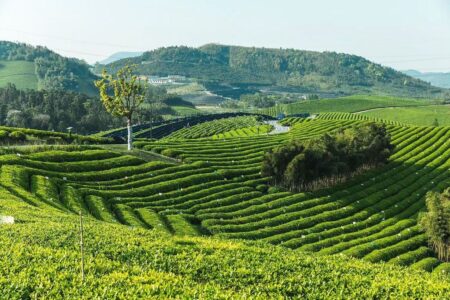New Opportunities for Single Origin and Specialty Teas

The growing demand for premium cups sees single origin and specialty teas gradually conquering Western tea lovers.
By Barbara Dufrêne All photos courtesy of Barbara Dufrêne
It seems that the time has come to finally unlock the huge potential offered by single origin and specialty teas that have been coming to the Western markets for several decades and attract discerning and educated consumers. While they are acknowledged in their respective origin countries, they also deserve appropriate status in the consumer markets, which could be achieved by setting up benchmarks and reference elements. A simple set of a few basic rules should give these fine teas defined identity and profile.
Tea became the world’s number one hot cup in 2008 by outranking coffee per global production volume and global numbers of daily cups according to International Coffee Organization and International Tea Committee statistics. It may therefore now be appropriate to implement some global structuring and to establish a framework for this premium cup market segment, which are the highly sought after single origin and specialty teas, generally also carrying the highest added value.
Shifting, Competing and Growing
Tea is a highly complex product; there are many variables that define different product categories, which characterize the various consumer markets and in turn impact marketing strategies. There are markets that consume mainly black teas, and others that consume mainly green teas. There are more dividing lines in terms of CTC (Cut, Tear and Curl) tea bags versus loose-leaf teas sold in bulk, mainstream teas versus specialty teas, single origin local teas versus tea blends, natural teas versus scented teas, breakfast and tea-time teas versus all day round cups, and pleasure cups versus boost and functional teas.
During the past decade or so many tea consuming markets have seen their traditional pattern shift towards both more novelty and higher quality teas, but also from mainstream teas to fine coffees, with a parallel shift from mainstream coffees to fine teas. The change in lifestyle of the more urban, more stressed, more educated and more health-oriented consumers, has resulted in growing awareness about the close link between premium quality and specific origins.
Looking at the way specialty coffees are enthusiastically embraced by the traditional green tea drinkers in China, Japan and Korea should convince specialty tea producers to target the Western mainstream coffee drinkers by widely promoting their specialty teas. Specialty coffee has set the pace and shows the path for a global launch of specialty teas setting out to conquer new markets.
Unlocking the Potential
In order to ensure a fruitful starting position for promoting specialty teas, the first step should be to agree a basic definition for origin and specialty teas. This could be done by following a long-established approach, traditionally used in China since ancient times, and which takes into account five criteria that make a tea truly special and unique:
- P1 – terroir or where the tea grows. The origin for agricultural products brings along unique quality due to the micro-climatic, soil and topographic conditions. The terroir concept is well known in the West for fine wines that are made in specific and limited estates, and the same concept fully applies to fine teas. Some already have Protected Geographical Indications (PGI) granted on a national level such as China, Korea, Indonesia, and by the EU for the Darjeeling Tea Estates in India, and for the Longjing tea areas in Zhejiang Province, China.
The “place” maybe a slope in the estate, an estate, a village, or a region. It is not the size but the well-defined delimitation that qualifies most specialty teas as origin teas, and usually the place will be part of the name, from Ceylon tea to Darjeeling tea to Keemun or Qimen black tea to Kakegawa Fukamushi tea, there are hundreds more of them.
- P2 – the plant’s botanical variety. On top of the basic distinction between the assamica and the sinensis variety there are many more tea bush varieties, which have either naturally developed in a specific environment and micro-climate or have been obtained in the national Tea Research Institutes (TRI) through the science of plant engineering and cross breeding for the purpose of increasing yield, improving pest and draught resistance, raising the cup quality, and adapting to mechanical harvesting. Furthermore, the age of the tea bush or tea tree can impact the cup quality and science also attempts to assess how the trees, bushes and flowers that surround the tea plantation can impact the aromatic quality of the leaves.
- P3 – the picking season or picking date. The timing of the harvest is key for the quality of specialty teas, with the first spring harvests usually being the best in countries where cold winters allow the gardens to rest, and the arrival of the rains that reinvigorate the bushes in the countries where tea is harvested year-round. A specialty tea should bear an indication of the picking time, be it a day, a lunar period, or a season, such as the frost wulongs from Taiwan, the Nilgiri frost teas, or the ming qian green teas from China.
- P4 – process of manufacturing. In ancient times teas were handmade, either sun dried or pan fried or steamed for the green teas, and oven fired for the black teas, and there were many ways to shape, roll, twist, and flatten the leaves. Today, machines have taken over most of the processing, but the distinction between leaf tea and CTC remains an important quality criterium together with grading according to leaf and particle size.
- P5 – perfume, aroma and taste. With specialty teas coming from specific places, specific bushes, picked at specific moments and processed in specific ways, the ultimate goal is to achieve premium flavour and aroma quality. All these cups have their proper premium taste profile, which is their main attraction for the consumers. Stemming from the P1 to P4 identification elements, it is the cup with its full and complex range of flavour and taste notes that the consumer wishes to savour and will pay for, despite the likely higher price point.
Agreeing on these basic definition elements will enhance the teas by offering a better understanding of their premium quality. It will also be an incentive for the consumer to learn more about such teas and then be proud to display their knowledge and ability to discern and to appreciate. Many Western consumers are, by now, fully familiar with the training of tea sommeliers, another expression coming from the fine wine market, and are keen to know more about their favourite cups and to discover more of them. A set of reference criteria will also assist with eliminating imposters, and hence guarantee fair competition and full traceability.
Progress Towards More Recognition
“Our premium white teas are made from the buds picked from the cultivar Gambung #7, developed by our TRI. Beautiful and tasty, the cup also has high functional properties, and we need to make the consumer fully aware of this. As a first step, we obtained a PGI from our government in 2014,” said Dr Rohayati Suprihatini, from Indonesia.
In 2008, Professor LUO Shaojun, former director of the Hangzhou Tea Quality Control Institute, submitted a formal request to the ISO Tea sub-committee for the protection of the most famous green and white Chinese origin teas, to ensure fair competition and avoid imitation and fake products.
“Today, we have methods that assess the labelled origin as true or fake by comparing the conformity of the leaf sample from the market to a sample of the origin tea. This ad hoc technology, based on stable isotope analytics, is less costly than elaborating a full analytical control method,” indicated Joerg Lickfett, from Eurofins Food Testing in Hamburg, Germany.
The debate over protecting tea from specific regions is ongoing, but there has not yet been any formal follow up by the existing global organizations for tea: FAO Intergovernmental Group on Tea, Rome, Italy; the International Tea Committee, London, UK; and the recently launched Tea Masters Cup International, Moscow, Russia. The issue will hopefully become an agenda point in one of the forthcoming meetings in 2018.
Barbara Dufrêne is the former Secretary General of the European Tea Committee and editor of La Nouvelle du Thé. She may be reached at: b-dufrêne @orange.fr.



